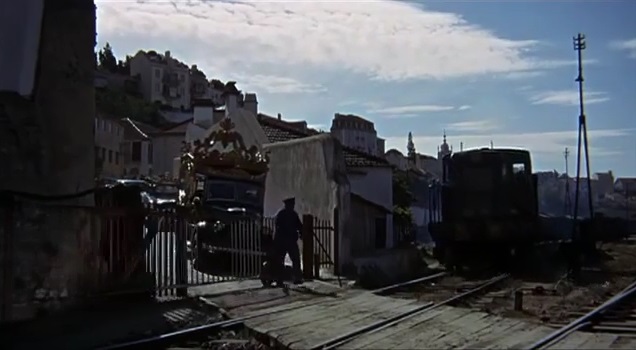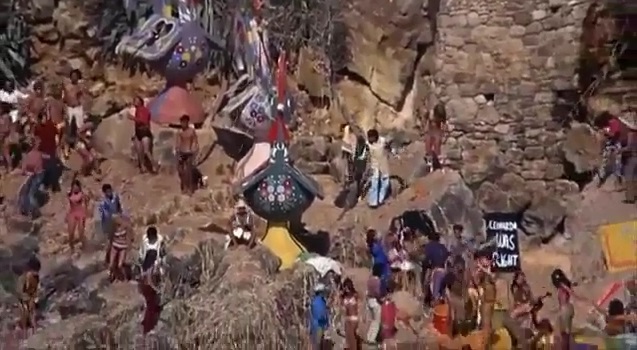Top
O’ the Morning
Theft of the
Blarney Stone, for nefarious purposes not thought of. Village
police to investigate, and a detective from Cork,
lastly a New York insurance investigator to avoid the claim.
The legend of a love,
and a singer, the tunes of old Ireland and some new ones. The
innermost of the land is reached in several numbers, one by Thomas Moore. The terrible legend proceeds along merrily, and the tale
of the absconding combines with all in a work of genius.
Bosley Crowther of the New York Times found that Crosby and
Blyth “keep the picture from becoming utterly
maudlin and banal.”
Love Happy
Critics were
taken aback, and one can’t help believing they prefer it that way. After all, Madame’s whammy on Harpo
produces the greatest hilarity of articles from his person, and these include a
barber’s pole. Surrealists liked Marx
shenanigans for the poetic truth in them, and so probably did Madame.
The critics were
hoping for the cat’s dinner, those Romanoff diamonds.
The Story of Esther Costello
It seems likely
that most reviewers at the time could not understand this,
certainly Variety and Bosley Crowther of the New
York Times could not, Halliwell’s Film Guide likewise.
The first part is
very ably analyzed in Arthur Penn’s The Miracle Worker, the second
in Richard Brooks’ Elmer Gantry. The
third, which strikes a note from Jean Negulesco’s Johnny Belinda
that reveals the evident source of Miller’s film, correctly serves as the
pivot and base of the work, and all at once places the characters one and all
in the proper perspective.
This was beyond
the reach of critics then, we may well believe. Sidney
James is absolutely authentic as an American newspaper editor, however, and
that should tell you something.
Midnight Lace
The London
financier and the American heiress. Memories of El Alamein, rebuilding London, a sailor in Singapore dry-dock. Hitchcock’s Suspicion is the well-disguised
basis (Halliwell did not even notice it, neither did anyone else, he
furthermore describes the film as “thoroughly silly”), along with
Anthony Dawson from Dial M for Murder. There is
“that Elliott business” forcing the exposure of an embezzlement,
thanks to an ambitious junior.
It opens with a
clownish death threat in fogbound Grosvenor Square, and
painting “Horatio Nelson pink!” The
maid’s son is a wastrel in PR. Joseph Gershenson
conducts the well-filmed Swan Lake charity ballet that helps convey the
secondary theme of a doubtful wife.
Bosley Crowther of the New York Times considered it posh
and nothing else. Time Out Film Guide is not
very keen (“suavely effective”), following a very superficial
analysis by Variety (“the emphasis is on visual
satisfaction”), whereas the intricacy of the structure is indicated in
the title.
Back Street
A fashion designer
(Susan Hayward) meets a department store heir (John Gavin), he’s married. She advances in her domain as artisan and assistant and
partner in the House of Dalian (a fitting resemblance is offered by Reginald
Gardiner). The wife is a drunken harridan perfectly
played by Vera Miles, there are two kids.
The metaphor is
suitably expressed in Kazan’s The Last Tycoon, among other things,
the “prestige picture”.
According to
Bosley Crowther of the New York Times,
“a moral and emotional fraud.”
A great and authoritative
masterpiece, with a perfectly straight face and the last laugh.
Lonely Are the Brave
The moral
position of the Westerner is tried to the utmost by an adherent, this is the
cause of a perfectly subtle and amazingly precise screenplay (it needed no
revision, as Kirk Douglas has pointed out, uniquely), and a style of direction
at once uncommonly heroic and exceptionally delicate (the Golden Reel Award for
sound editing takes perfect cognizance of this).
Variety, however, could not recognize the
very premise laid out so diligently, and therefore defined as
“symbolism” what is really straightforward discourse. The infra-slim of Trumbo’s
screenplay nevertheless makes impossible the resolution offered, which anyway
is deliberately ambiguous, a question of métier.
Captain Newman, M.D.
A key film, as
often noted in this latter day, that points up the obvious absurdity of the
Army ban on Huston’s documentary, Let There Be Light. The filmmakers must have known it, or else direct
experience had its part to play.
Several of the
cases reflect the suffering inflicted on psyches in the field, thus Corporal
Tompkins and Captain Winston, both shot down. Col.
Bliss is another type entirely, a full-blown psychosis born of command and
drowned in battle losses, he’s “Mr. Future”,
completely divorced from “Mr. Past”.
The classical
Hollywood technique shows Capra visibly and right through to Boleslawski, the acting is everything that could be
expected. The surprise appearance of Italian POWs
accomplishes the epiphany of Ezra Pound as a chip off the old Christmas tree.
Hammerhead

The
singular analysis is by Samuel Fuller in Tigrero, a film abandoned in
pre-production (vd. Mika Kaurismäki). The influence of
Terence Young’s Thunderball is evident and part of the joke
in a tale of an art collector with a penchant for pornography, cf. Hawks’ The Big Sleep.
The
approach to the villa at Lisbon by wavestruck seawall
and cliff is from Hitchcock’s North
by Northwest. Case of the jockey with a nom de guerre, “I-I-I never told
‘em me—real name’s—Mullens.”
A
thorough meditation on art in all its degrees and stations, from happenings to
Henry Vaughan, mimesis, Truth and Beauty. “Oh, I
beg your pardon. I thought this was the Family Circle
Home Movie Club. Thank you.”

Dialogue in the
bonds of death. “Can you get hold of it?”
“Mmh. Yeah. Yeah.
I’ve got it.”
“OK, now,
now, work it up and down. That’s it.”
“I-is it
coming?”
“Almost.”
“Ohhh! There!”
“What a relief.” View
from the casket en route, cf. Dreyer’s Vampyr. A parody of The Man Who Knew Too Much (second version) accomplishes the
switcheroo. Life on a passing motorcyclist. Variant of The 39
Steps, “the report is divided into four sections...”
Andrew Sarris (The American Cinema), “how a David
Miller cult ever got started is one of the unsolved mysteries of underground
criticism.”
Dan Sullivan of
the New York Times, “competent
schlock.” Catholic News Service Media Review
Office, “sluggish”. Dan Pavlides (All Movie
Guide), “uneven”. Halliwell’s Film Guide, “jaded”.

Executive Action
The fictional
conspirators, their hired marksmen, their patsy’s stooge, their political
considerations, their power and influence. A brief
history of assassinations and failures, with a critique. History
of the patsy, a creation of intelligence. Activities
of the stooge. Three marksmen (grassy knoll,
depository window, records bldg. roof). Fall of the
patsy. Death of a conspirator, at Parkland Hospital. Disappearance of witnesses.
The Bay of Pigs
is mentioned, the conspiracy resembles in certain aspects the Watergate affair. A reporter asked President Kennedy about the attitude of
“big business” that “we have you where we want you.” The President replied, standing at the podium
bearing the Seal of the President of the United States for all to see, “I
can’t believe I’m where big business wants me.”